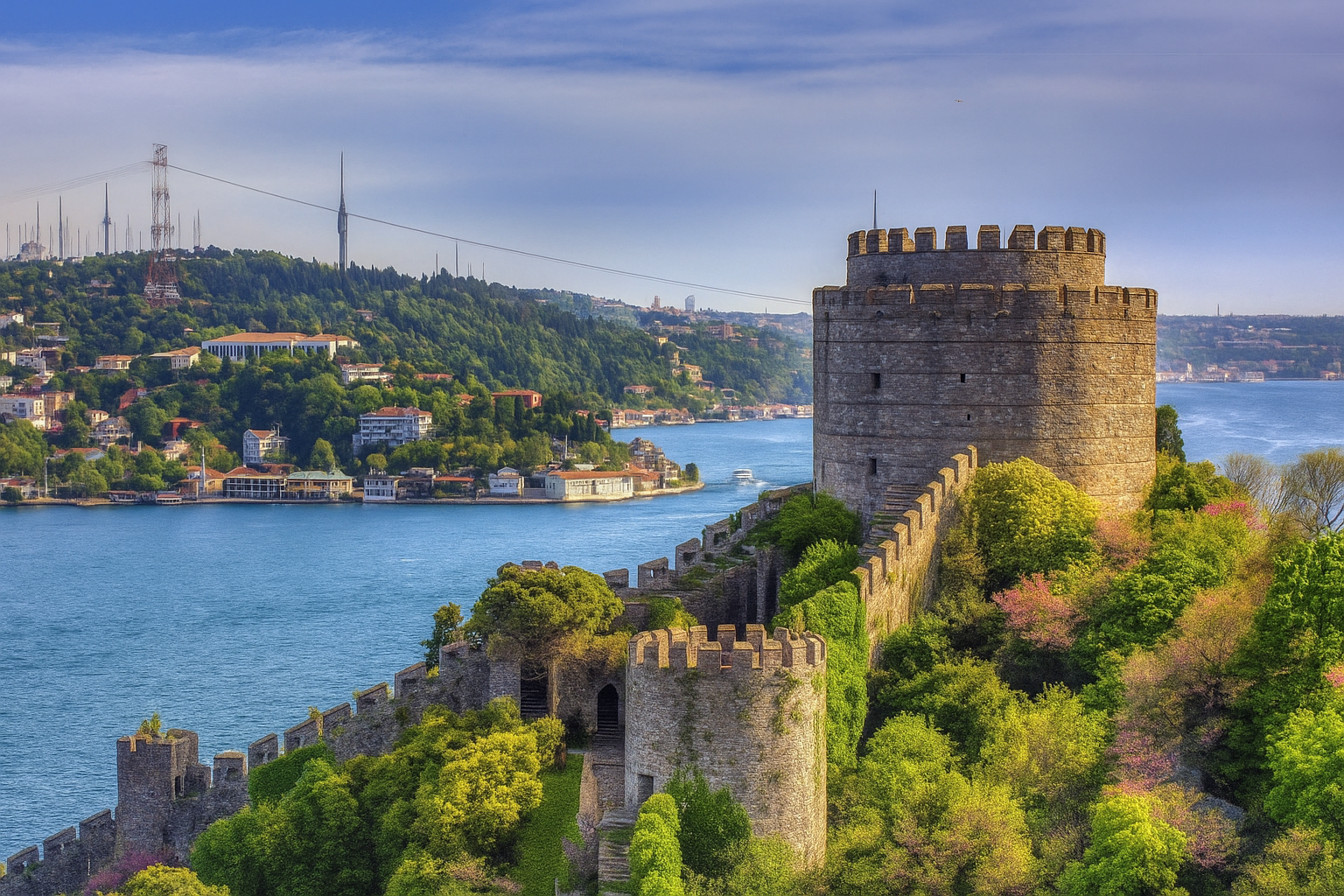
Rumeli Hisarı (Rumeli Fortress)
HISTORICAL BACKGROUND AND SIGNIFICANCE
Rumeli Hisarı, also known as Rumeli Fortress, is a monumental structure located on the European side of the Bosphorus Strait in Istanbul, Turkey. Constructed between 1451 and 1452 under the orders of Sultan Mehmed II, this fortress was strategically built to control maritime traffic and to prevent any potential aid from reaching the Byzantine capital of Constantinople during its siege. The fortress played a crucial role in the Ottoman conquest of Constantinople in 1453, serving as a defensive bastion against the city’s naval forces.
The site of Rumeli Hisarı has a rich history that predates its construction. The area was known as a strategic point for centuries, with various fortifications established by different empires. However, it was Mehmed II, also known as Mehmed the Conqueror, who recognized the importance of this location in his campaign against Constantinople. The fortress not only served military purposes but also symbolized the might and ambition of the Ottoman Empire.
ARCHITECTURAL FEATURES AND DESIGN ELEMENTS
Rumeli Hisarı is an impressive example of military architecture, showcasing the engineering prowess of the Ottomans. The fortress is characterized by its three main towers: the largest, known as the "Grand Tower" (Büyük Kule), stands at 28 meters high, while the other two towers, the "Small Tower" (Küçük Kule) and the "Fatih Tower," are slightly shorter yet equally formidable.
The fortress is built from local limestone and features a series of walls and battlements that were designed to withstand sieges. The walls are adorned with arrow slits and gun ports, allowing defenders to repel attackers effectively. The layout of the fortress is strategic, with a triangular shape that maximizes visibility and control over the Bosphorus. The use of crenellations along the walls adds to the fortress's imposing appearance, making it a striking landmark along the strait.
CULTURAL AND RELIGIOUS IMPORTANCE
Beyond its military significance, Rumeli Hisarı holds cultural importance as a symbol of the Ottoman Empire's expansion and dominance in the region. The fortress represents the transition from Byzantine to Ottoman rule, marking a pivotal moment in history that reshaped the cultural landscape of Istanbul.
In addition to its historical significance, Rumeli Hisarı has also been a site for various cultural events and festivals. The fortress hosts concerts, art exhibitions, and theatrical performances, allowing visitors to engage with the cultural heritage of Istanbul in a unique setting. The surrounding gardens and scenic views of the Bosphorus add to the cultural ambiance, making it a popular spot for both locals and tourists.
VISITOR EXPERIENCE AND WHAT TO EXPECT
Visiting Rumeli Hisarı is an immersive experience that combines history, architecture, and stunning views. Upon arrival, visitors are greeted by the fortress's towering walls and impressive gates. The entrance fee is modest, and the site is well-maintained, providing a clean and accessible environment for exploration.
Inside the fortress, visitors can wander through the various towers and walls, each offering panoramic views of the Bosphorus and the Asian side of Istanbul. The climb to the top of the Grand Tower is particularly rewarding, as it provides a breathtaking perspective of the strait and the surrounding landscape. Informational plaques throughout the site offer insights into the fortress's history and architectural features, enhancing the educational experience.
The gardens surrounding the fortress are perfect for a leisurely stroll or a picnic, allowing visitors to relax and soak in the atmosphere. There are also small cafes where guests can enjoy refreshments while taking in the scenic views.
INTERESTING FACTS AND ANECDOTES
1. **Construction Speed**: Remarkably, Rumeli Hisarı was constructed in just four months, a testament to the efficiency and determination of Mehmed II and his workforce. 2. **Cultural Symbol**: The fortress has appeared in various Turkish films and television series, further embedding it in the cultural consciousness of the nation. 3. **Historical Events**: During the Ottoman period, Rumeli Hisarı was not only a military stronghold but also a royal residence and a place for state ceremonies, showcasing its multifaceted role in Ottoman society.
PRACTICAL VISITING INFORMATION
- **Hours**: Rumeli Hisarı is open to visitors daily from 9 AM to 7 PM during the summer months and from 9 AM to 5 PM in the winter. It is advisable to check for any seasonal changes in operating hours before planning your visit. - **Best Times to Visit**: The best times to visit are during the spring and fall when the weather is mild, and the gardens are in full bloom. Early mornings or late afternoons are ideal for avoiding crowds and enjoying the sunset views over the Bosphorus. - **Tips**: Wear comfortable shoes, as the fortress involves a fair amount of walking and climbing. Bringing a camera is a must, as the views are spectacular. Additionally, consider visiting during one of the cultural events for a more enriching experience.
In conclusion, Rumeli Hisarı is not just a fortress; it is a testament to the rich history and cultural heritage of Istanbul. Its strategic significance, architectural beauty, and cultural relevance make it a must-visit destination for anyone exploring the vibrant city of Istanbul.